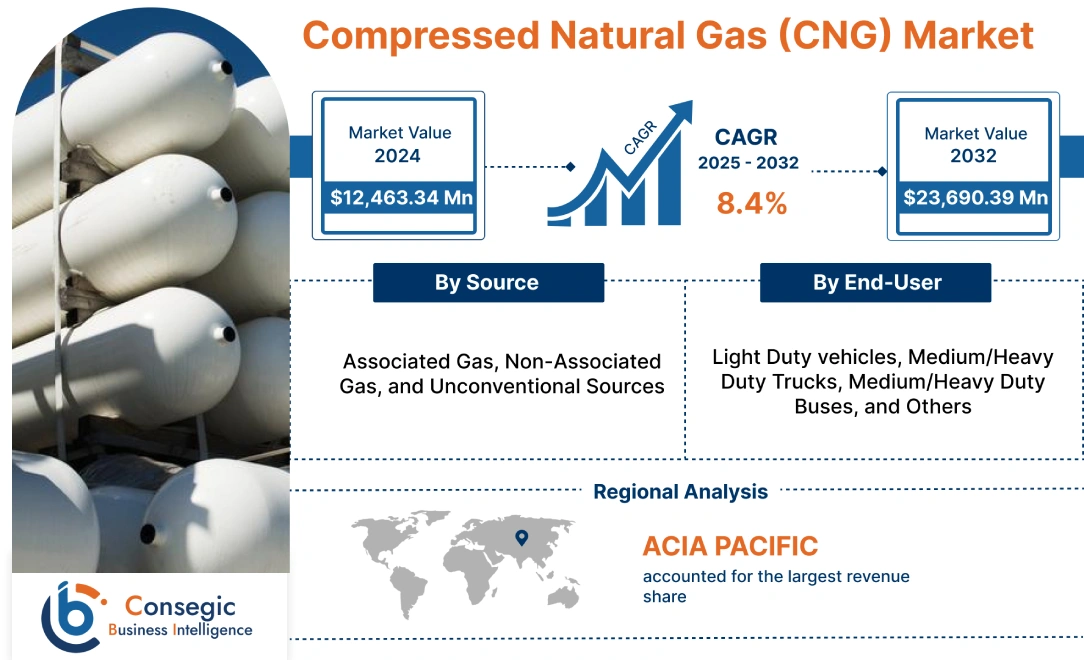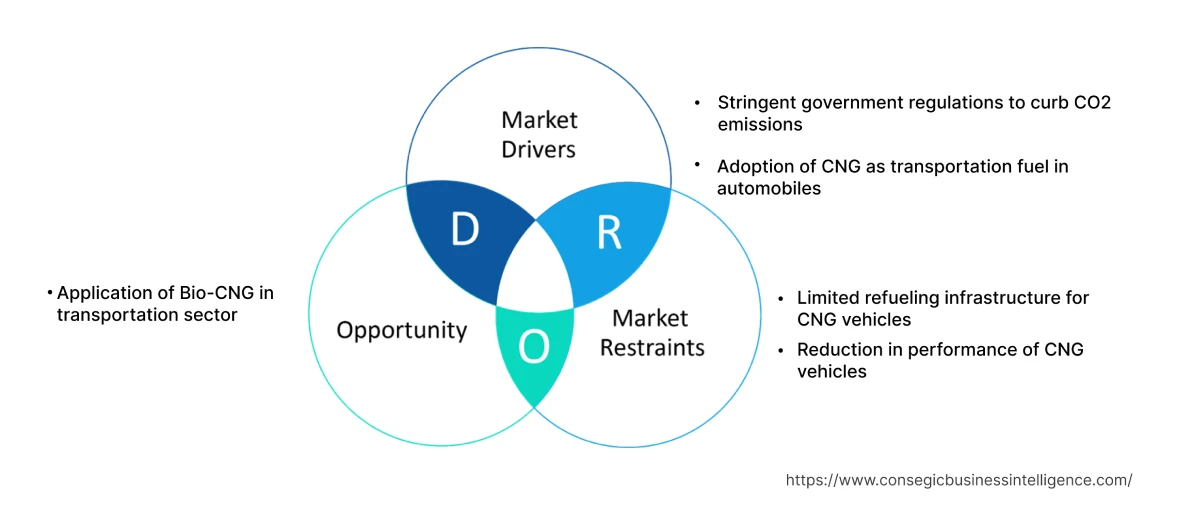- Summary
- Table Of Content
- Methodology
Compressed Natural Gas (CNG) Market Size :
Compressed Natural Gas (CNG) Market size is estimated to reach over USD 23,690.39 Million by 2032 from a value of USD 12,463.34 Million in 2024 and is projected to grow by USD 13,283.20 Million in 2025, growing at a CAGR of 8.4 % from 2025 to 2032.
Compressed Natural Gas (CNG) Market Scope & Overview:
CNG is known as a cleaner-burning fuel compared to gasoline and diesel as it produces lower emissions of pollutants including carbon dioxide (CO2), nitrogen oxides (NO2), sulfur dioxide (SO2), particulate matter, and toxic compounds. Compressed natural gas (CNG) is considered a substitute fuel primarily composed of methane gas (CH4) that is compressed to less than 1% of the volume at standard atmospheric pressure. Moreover, it is used as a fuel in internal combustion engines, particularly in automotive vehicles including cars, buses, and trucks.
Compressed Natural Gas (CNG) Market Insights :
Key Drivers :
Stringent government regulations to curb CO2 emissions
Government and regulatory bodies worldwide are implementing stricter emission standards and regulations to reduce air pollution and combat climate change. Burning fossil fuels including diesel and gasoline releases carbon dioxide into the atmosphere. As a result, the accumulation of harmful greenhouse gases such as nitrous oxide (NO2), carbon dioxide (CO2), and hydrofluorocarbons (HFCs) is leading to warm atmospheric temperatures, resulting in significant climate change. For instance, according to the United States Environmental Protection Agency (EPA), Greenhouse Gas (GHG) emissions from the transportation sector in the United States are the largest contributor to approximately 29% of total greenhouse gas emissions. Moreover, government and regulatory bodies across the world are providing subsidies, tax benefits, and incentives to promote the adoption of CNG gas, resulting in the compressed natural gas (CNG) market growth.
Adoption of CNG as a transportation fuel in automobiles
The rise in the adoption of CNG-powered vehicles due to low operational cost and environment friendliness is driving the growth of the compressed natural gas market. CNG cars are cost-effective due to the low operational costs in comparison to conventional fuel types such as petrol and diesel. Moreover, CNG cylinders are non-toxic in comparison to gasoline and diesel tanks due to their structure, size, and location within the vehicle. Additionally, these cars produce less emissions to the environment, thereby accounting for the environment-friendliness of CNG gas.
- For instance, in January 2022, Maruti Suzuki India Limited launched Celerio with S-CNG Technology to strengthen its green vehicle portfolio in India. In conclusion, compressed natural gas is considered a clean transportation fuel and is widely used in light-duty and heavy-duty vehicles, resulting in the rise of compressed natural gas (CNG) market demand.
Key Restraints :
Limited refueling infrastructure for CNG vehicles
The growth of the compressed natural gas (CNG) market is significantly constrained by the limited availability of refueling infrastructure. CNG refueling stations are far fewer in number compared to the widespread network of petrol and diesel stations, making it less convenient for consumers to adopt CNG vehicles. This limited infrastructure creates a significant barrier to widespread adoption, especially in rural or less-developed regions, where refueling stations are sparse. As a result, many potential users hesitate to transition to CNG vehicles due to concerns about access to refueling, slowing the market's expansion. Therefore, the analysis of market trends depicts that expanding the CNG refueling network is therefore crucial to promoting consumer confidence and supporting compressed natural gas (CNG) market growth.
Reduction in performance of CNG vehicles
One of the key challenges with CNG vehicles is the reduced performance due to the lower energy density of compressed natural gas compared to traditional fuels like petrol and diesel. This means that CNG-powered vehicles typically have less power and slower acceleration, which may not appeal to all consumers, particularly those seeking high-performance vehicles. Additionally, because CNG produces less energy per unit of fuel, vehicles running on CNG experience a reduction in range, requiring more frequent refueling. While CNG offers a cleaner alternative to traditional fuels, the trade-off in vehicle performance can limit its attractiveness to consumers who prioritize speed and power. Addressing these performance limitations through advanced engine technologies or hybrid systems could help boost compressed natural gas (CNG) market demand.
Future Opportunities :
Application of Bio-CNG in the transportation sector
The application of Bio-CNG in the transportation sector is expected to present potential opportunities for the growth of the Compressed Natural Gas Market. Bio-CNG (Compressed Natural Gas) is refined biogas made from animal manure, agricultural waste, food waste, and sewage water. As a result, Bio-CNG is a cleaner fuel that is expected to provide numerous advantages such as high calorific value and cost savings over conventional fuels. Therefore, the market trends analysis depicts that the further application of Bio-CNG as a renewable vehicle fuel is expected to drive the compressed natural gas (CNG) market opportunities during the forecast period.
Compressed Natural Gas (CNG) Market Report Insights :
| Report Attributes | Report Details |
| Study Timeline | 2019-2032 |
| Market Size in 2032 | USD 23,690.39 Million |
| CAGR (2025-2032) | 8.4% |
| By Source | Associated Gas, Non-Associated Gas, and Unconventional Sources |
| By End-User | Light Duty vehicles, Medium/Heavy Duty Trucks, Medium/Heavy Duty Buses, and Others |
| By Region | North America, Europe, Asia-Pacific, Latin America, and Middle East & Africa |
| Key Players | Cabot Oil & Gas Corporation, Indraprastha Gas Limited, ConocoPhillips Company, ENGIE Group, Exxon Mobil Corporation, Chevron Corporation, J-W Power Company, National Iranian Gas Company, Shell group of companies, Trillium Transportation Fuels |
Compressed Natural Gas (CNG) Market Segmental Analysis :
By Source :
Based on the source, the market is trifurcated into associated gas, non-associated gas, and unconventional sources.
The non-associated gas segment accounted for the largest revenue share of 46.09% of the total compressed natural gas (CNG) market share in the year 2024.
Non-associated gas is natural gas that is extracted from a natural gas well, rather than an oil well. Non-associated gas is produced through drilling techniques and then processed to remove impurities from recovered natural gas. Furthermore, non-associated gas is further compressed to be utilized as a transportation fuel in CNG vehicles. The majority of United States natural gas production is from non-associated gas.
- For instance, according to the U.S. Energy Information Administration, U.S. dry natural gas (non-associated gas) production was approximately 10.8% greater than total U.S. natural gas consumption in 2022.
Therefore, the segmental trends analysis shows that the utilization of non-associated gas to power CNG vehicles is propelling the compressed natural gas (CNG) market trends.
The unconventional sources segment is anticipated to register the fastest CAGR during the forecast period. Unconventional natural gas requires advanced production methods such as hydraulic fracturing for extraction from shale gas, tight gas, coalbed methane (CBM), and gas hydrates. The extraction of unconventional gas by hydraulic fracturing is cost-effective as the gas is highly dispersed in the rock, rather than occurring in a concentrated underground location. Therefore, the segmental trends analysis suggests that the utilization of unconventional gas for the production of compressed natural gas is cost-effective and is further expected to drive compressed natural gas (CNG) market expansion during the forecast period.
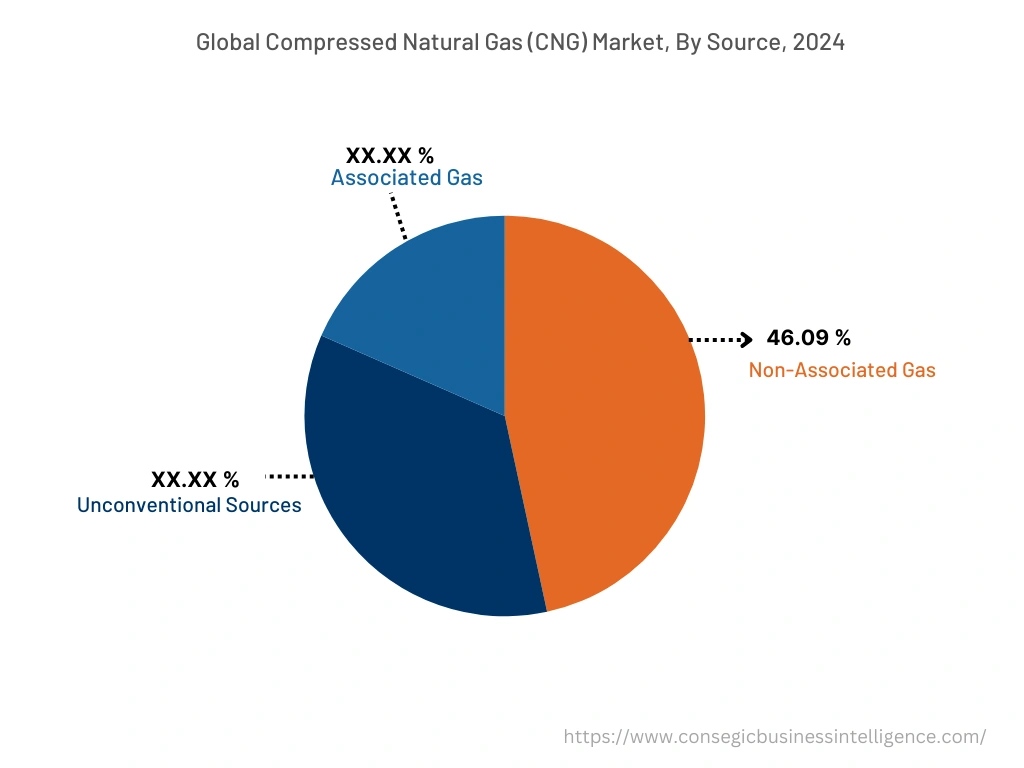
By End-User :
Based on the end-user, the market is segregated into light-duty vehicles, medium/heavy-duty trucks, medium/heavy-duty buses, and others.
Light duty vehicles accounted for the largest revenue share of the overall compressed natural gas (CNG) market share in the year 2024. The increasing demand for environmentally friendly fuels in automobiles is driving the growth of this segment. Several light-duty vehicle manufacturers such as Toyota, Honda, General Motors, and Suzuki introduced in-built CNG fuel tanks owing to the low maintenance and increased efficiency of the vehicle.
Medium/heavy-duty buses are expected to witness the fastest CAGR during the forecast period. Several public vehicles such as medium and heavy-duty buses specifically in countries including India are being converted to CNG-based fuel systems owing to the low maintenance costs and environment-friendliness of CNG fuels.
- For instance, in November 2021, Ashok Leyland India launched ultra-low floor CNG BS VI Buses for IndiGo Airlines.
Therefore, the analysis of segmental trends shows that the growing adoption of CNG fuels in medium and heavy-duty buses is driving the compressed natural gas (CNG) market trends during the forecast period.
By Region :
The regional segment includes North America, Europe, Asia Pacific, the Middle East and Africa, and Latin America.
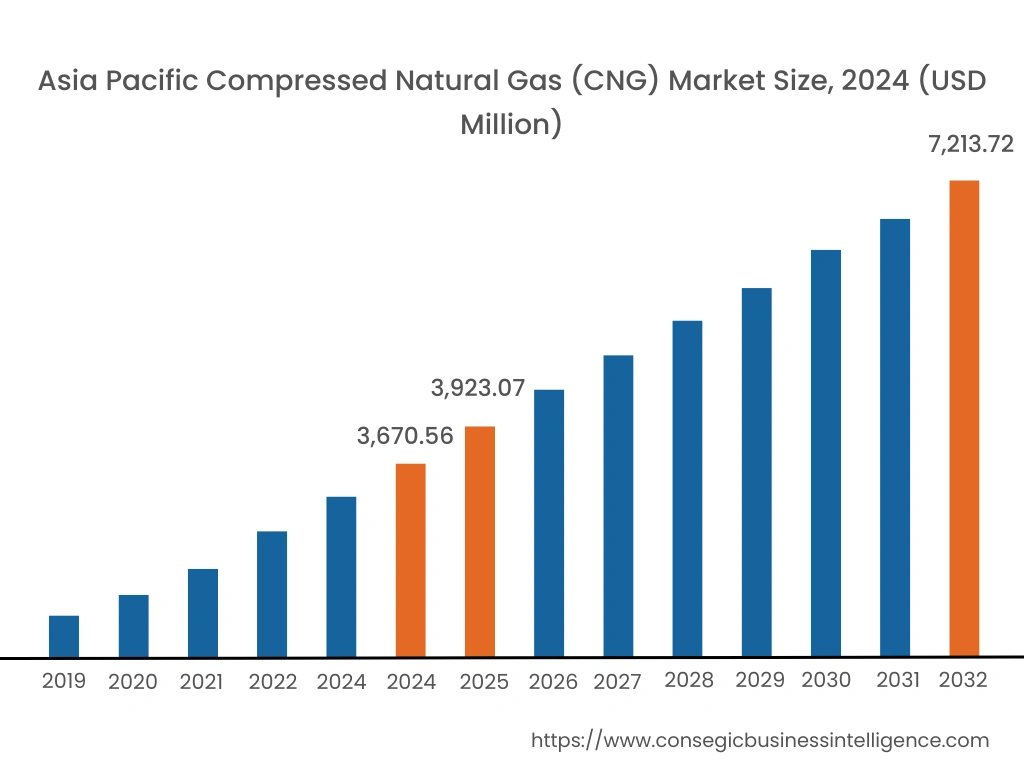
Asia-Pacific accounted for the largest revenue share of USD 3,670.56Million in 2024 and is expected to reach USD 7,213.72 Million by 2032, registering a CAGR of 8.8% during the forecast period. In addition, in the region, China accounted for the maximum revenue share of 29.7% in the same year. The presence of abundant natural gas resources in the Asia-Pacific region is driving the compressed natural gas (CNG) market expansion. Countries including India, China, and Australia have abundant natural resources and are constantly discovering opportunities to explore the production of Compressed Natural Gas (CNG). Moreover, with the growing transportation and automotive sectors in the region for applications including light and medium-duty vehicles movement is propelling the demand for CNG. Moreover, the regional trends analysis depicts that rising government initiatives and policies to reduce carbon emissions from the transportation sector are further propelling the growth of the market.
North America is expected to register fastest CAGR growth of 8.8% during the forecast period. The shale gas revolution in North America, particularly in the United States, has significantly increased natural gas production and expanded the availability of CNG as an alternate fuel option.
- For instance, according to the TC Energy Corporation, U.S. natural gas demand is expected to grow over 27% by 2030.
Therefore, the compressed natural gas (CNG) market analysis shows that the increasing demand for compressed natural gas in automobiles in North America is proliferating the market.
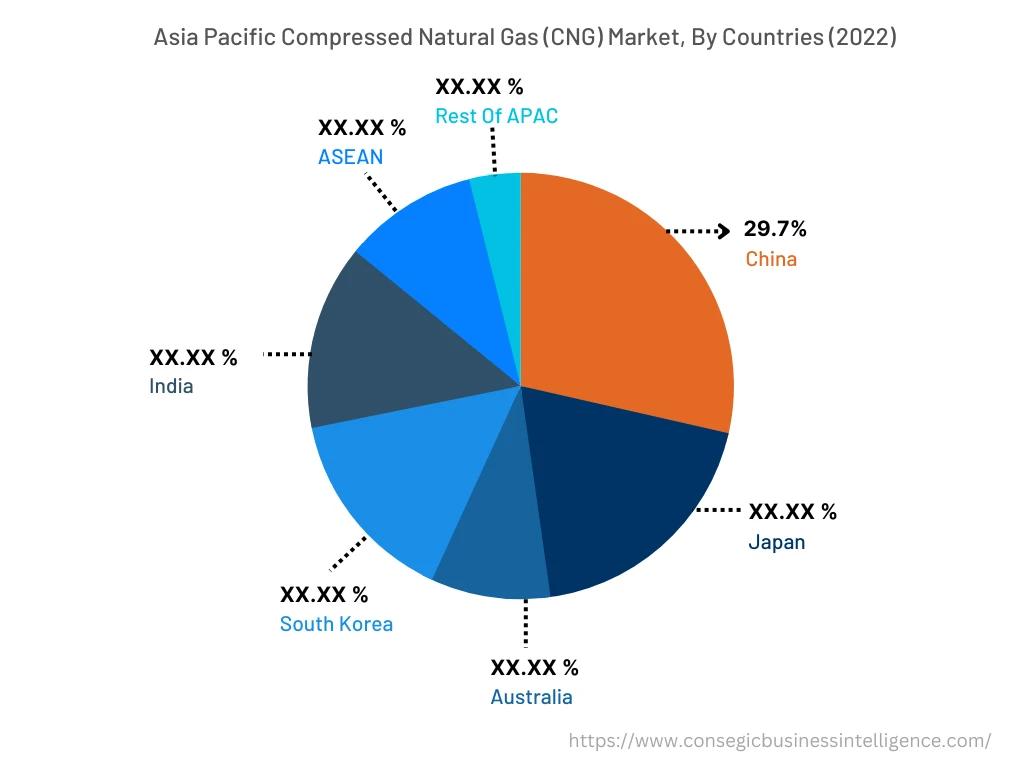
Top Key Players & Market Share Insights:
The global compressed natural gas (CNG) market is highly competitive with major players providing products and services to the national and international markets. Key players are adopting several strategies in research and development (R&D), product innovation, and application launches to hold a strong position in the market. Key players in the Compressed Natural Gas (CNG) industry include -
- Cabot Oil & Gas Corporation
- Indraprastha Gas Limited
- ConocoPhillips Company
- ENGIE Group
- Exxon Mobil Corporation
- Chevron Corporation
- J-W Power Company
- National Iranian Gas Company
- Shell group of companies
- Trillium Transportation Fuels
Recent Industry Developments :
- In November 2022, Toyota Kirloskar Motor launched the Toyota Glanza and Urban Cruiser Hyryder model line-up fitted with CNG kits to cater mobility needs of Indian consumers.
- In January 2023, Maruti Suzuki India Limited launched the Grand Vitara S-CNG featuring a 1.5-litre, Dual Jet, Dual VVT engine to provide high driving performance.
Key Questions Answered in the Report
What is Compressed Natural Gas (CNG)? +
Compressed Natural Gas (CNG) is derived from natural gas mainly comprised of methane that is stored under high pressures. CNG is an eco-friendly alternative to gasoline and petrol as it produces less carbon emissions in the environment.
What specific segmentation details are covered in the Compressed Natural Gas (CNG) report, and how is the dominating segment impacting the market growth? +
The report consists of segments including source and end-user. Each segment has key dominating sub-segment being driven by the industry trends and market dynamics. For instance, by source has witnessed non-associated gas as the dominating segment in the year 2024, as non-associated gas is utilized for the production of CNG gas to power automotive vehicles.
What specific segmentation details are covered in the Compressed Natural Gas (CNG) market report, and how is the fastest segment anticipated to impact the market growth? +
The report consists of segments including source and end-user. Each segment is projected to have the fastest-growing sub-segment being fueled by industry trends and drivers. For instance, by end-user segment has witnessed medium and heavy duty buses as the fastest-growing segment during the forecast period due to the low-cost and environment-friendliness of CNG fuels for public transportation such as buses.
Which region/country is anticipated to witness the highest CAGR during the forecast period, 2025-2032? +
North America is expected to register fastest CAGR growth during the forecast period due to the shale gas revolution in North America for the product of natural gas.
